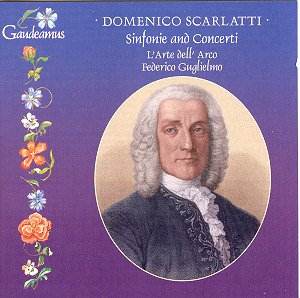I
have several problems with this Gaudeamus release. Firstly, I
selected this recording for review on the basis that it was a
disc of Domenico Scarlatti’s Sinfonie and concerti and
the front cover of the booklet bears that out. This release in
fact has three short Domenico Scarlatti scores with two Francesco
Durante compositions and a work each from Pergolesi, Barbella
and Leo. The music of both Durante and Pergolesi total more than
that of Scarlatti’s, so how can the disc be marketed as a Scarlatti
release?
Secondly,
the booklet notes seem pretty perplexing to me. I had to read
up on each composer in my New Grove before I worked out that the
common factor of this release is simply that all the five featured
composers were contemporaries and formed part of what is now known
as the ‘Neapolitan School’ which was active in composition and
teaching in Naples during the early part of the eighteenth century.
Frustratingly it was not easy to work out, nay impossible, from
information in the booklet notes, the various instrumental combinations
that are playing on each work.
Thirdly,
the music contained on the release is not of particularly high
quality and when I think that around that time the ‘prete rosso’
Antonio Vivaldi was working not too far away in Venice, the
contrasting quality seems ironic. Overall the selected works display
a most sparing use of ornamentation and there is a similar husbandry
in melodic ideas. Domenico Scarlatti is widely acknowledged as
a fine composer particularly in the genre of keyboard and sacred
music yet these three Sinfoniae do not show him at his
most memorable and seem pretty run-of-the-mill fare. The other
Concerto works on the disc are not the most imaginative
and inspiring scores to have come out of Italy in the late-baroque
era either and their composers are generally better regarded for
their Operas and Sacred music rather than for their brief forays
into concertante works.
The
substantial Concerto in B flat, from Pergolesi, which is
the longest work on the release is the pick of the litter, for
its attempted invention and expression. The lyrical and calming
second movement largo is particularly impressive. Barbella’s
Concerto in C which features a nicely played baroque flute
by Stefano Bagliano, has some interesting moments but all too
brief. The Durante Concerto in A ’La Pazzia’ is notable
for its many striking contrasts within each of its three movements
yet when there are fleeting episodes of imagination as in the
third movement allegro he tends to over-repeat the idea
showing an inability for development. Apart from his many Operas
and Sacred works Leonardo Leo wrote a very fine Concerto for
four violins and basso continuo which is available on Archiv
Produktion 445 612-2 played by Musica Antiqua Köln under
Reinhard Goebel. Leo’s Concerto in D minor is attractive
yet it doesn’t have the same imagination and authority as his
Concerto for four violins and the composer cannot seem
to cultivate his ideas sufficiently to maintain the interest.
Fourthly,
for me there is nothing finer than when late-baroque orchestral
and concertante works are played well on period instruments. The
performance from L’Arte Dell’Arco under Federico Guglielmo does
use period instruments however the sound quality on this Gaudeamus
release does not give the selected works their full justice. The
choice of the combination of cello, theorbo and violone in the
basso continuo section feels far too thick and heavy. With only
sparing use of the harpsichord and no baroque organ the possibilities
of adding a wider spectrum of colours was unfortunately missed.
Several of the instruments seem far too closely recorded, especially
the most resonant sounding violone, so much so I felt I was inside
the instrument on occasions. The close recording prevents any
real shine and smoothness in the tuttis and there is certainly
no beauty of tone to flatter any of the strings. With regard to
the direction of Federico Guglielmo it is most noticeable that
the phrasing is frequently hesitant.
By
way of a comparison there is a recording released last year of
Concerti and Sinfonie from Domenico Scarlatti and
his father. Using period instruments, under the direction of Fabio
Biondi and Europe Galante on Virgin Veritas 7243 545495 2 6 the
recording displays how marvellously it is possible to perform
Domenico Scarlatti’s Sinfonie.
This
disc of Domenico Scarlatti Sinfonie and Concerti that isn’t,
was not my most pleasurable listening experience.
Michael
Cookson
